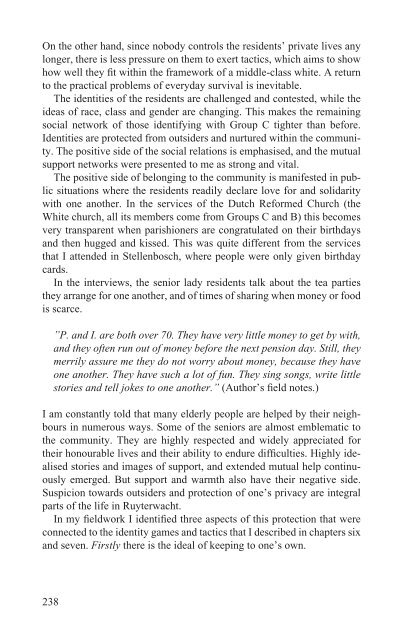The Making of a Good White - E-thesis - Helsinki.fi
The Making of a Good White - E-thesis - Helsinki.fi
The Making of a Good White - E-thesis - Helsinki.fi
You also want an ePaper? Increase the reach of your titles
YUMPU automatically turns print PDFs into web optimized ePapers that Google loves.
On the other hand, since nobody controls the residents’ private lives any<br />
longer, there is less pressure on them to exert tactics, which aims to show<br />
how well they <strong>fi</strong>t within the framework <strong>of</strong> a middle-class white. A return<br />
to the practical problems <strong>of</strong> everyday survival is inevitable.<br />
<strong>The</strong> identities <strong>of</strong> the residents are challenged and contested, while the<br />
ideas <strong>of</strong> race, class and gender are changing. This makes the remaining<br />
social network <strong>of</strong> those identifying with Group C tighter than before.<br />
Identities are protected from outsiders and nurtured within the community.<br />
<strong>The</strong> positive side <strong>of</strong> the social relations is emphasised, and the mutual<br />
support networks were presented to me as strong and vital.<br />
<strong>The</strong> positive side <strong>of</strong> belonging to the community is manifested in public<br />
situations where the residents readily declare love for and solidarity<br />
with one another. In the services <strong>of</strong> the Dutch Reformed Church (the<br />
<strong>White</strong> church, all its members come from Groups C and B) this becomes<br />
very transparent when parishioners are congratulated on their birthdays<br />
and then hugged and kissed. This was quite different from the services<br />
that I attended in Stellenbosch, where people were only given birthday<br />
cards.<br />
In the interviews, the senior lady residents talk about the tea parties<br />
they arrange for one another, and <strong>of</strong> times <strong>of</strong> sharing when money or food<br />
is scarce.<br />
”P. and I. are both over 70. <strong>The</strong>y have very little money to get by with,<br />
and they <strong>of</strong>ten run out <strong>of</strong> money before the next pension day. Still, they<br />
merrily assure me they do not worry about money, because they have<br />
one another. <strong>The</strong>y have such a lot <strong>of</strong> fun. <strong>The</strong>y sing songs, write little<br />
stories and tell jokes to one another.” (Author’s <strong>fi</strong>eld notes.)<br />
I am constantly told that many elderly people are helped by their neighbours<br />
in numerous ways. Some <strong>of</strong> the seniors are almost emblematic to<br />
the community. <strong>The</strong>y are highly respected and widely appreciated for<br />
their honourable lives and their ability to endure dif<strong>fi</strong>culties. Highly idealised<br />
stories and images <strong>of</strong> support, and extended mutual help continuously<br />
emerged. But support and warmth also have their negative side.<br />
Suspicion towards outsiders and protection <strong>of</strong> one’s privacy are integral<br />
parts <strong>of</strong> the life in Ruyterwacht.<br />
In my <strong>fi</strong>eldwork I identi<strong>fi</strong>ed three aspects <strong>of</strong> this protection that were<br />
connected to the identity games and tactics that I described in chapters six<br />
and seven. Firstly there is the ideal <strong>of</strong> keeping to one’s own.<br />
238
















